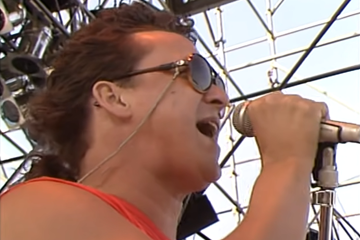'War For The Planet Of The Apes' Ups The Ante For This Unexpectedly Good Franchise Reboot
'The most artful, thoughtful, sombre, serious, ponderous, earnest, noble movie one could possibly make about talking apes.'
war for the planet of the apes

It’s like Ben-Hur, just with talking apes. Except for the moments where it’s like a respectful holocaust movie, just with talking apes. And those moments in which it’s a prison-break drama, just with talking apes. And all those times where it’s falling over backwards to make elaborate Apocalypse Now homage. Which come less with the talking apes, more with Woody Harrelson just straight-up impersonating Marlon Brando (watch him shave his bald Crazy Colonel’s head with a knife!). It’s War For The Planet Of The Apes, the most artful, thoughtful, sombre, serious, ponderous, earnest, noble movie one could possibly make about talking apes.
After an unexpectedly successful/good reboot, 2011’s contagion-unleashing, Francophonic Rise Of The Planet Of The Apes, director Matt Reeves brought genuine artistry to 2014’s Dawn Of The Planet Of The Apes, his beautifully-composed and thoughtfully-considered film one of the best blockbusters of recent years; all smart thematic resonance and beautifully-staged set-pieces. Reeves ups the ante on War For The Planet Of The Apes, his sincerity for the source text, and the world he’s creating, having only grown (and a scene in which darkness is lit up only by flashes of neon green laser-pointers, flaming torches, and gunfire is every bit as beautiful as anything he staged last time). Here, Apes mythology is conveyed with such unabashed reverence that it’s as if Reeves and co-writer Mark Bomback are summoning the prophets, dutifully intoning a bible story.
Don't miss a beat with our FREE daily newsletter
And, in some ways, they are: ape hero Caesar (mo-cap’d by Andy Serkis) a veritable Moses figure, leading his people out of slavery, in search of a homeland. It’s there that they’ll escape this rebooted trilogy, and that —as the fledgling characters named Cornelius and Nova suggest— one day Charlton Heston will crash his spaceship.
These Apes reboots have been about exploring the tilting power-balance between species, and have done so not just through action, but the telling of story. Rise was about humans: amoral CEOs and old timers with dementia, corporate malfeasance and father/son relationships, man playing God and having dominion over other creatures. Dawn was about humans and apes set on equal-footing; a frontier parable charting an uneasy first-contact meeting between surviving people and emancipated primates, with the story split between sides. This time, the narrative is anchored not with human characters, but with apes: the empathetic figures from the fringes of the first film now wholly owners of the narrative. This matches the revelation that the virus let loose in the first reboot is not only granting apes the ability to speak, but robbing humans of that same ability.
War For The Planet Of The Apes is, in such, essentially about communication, and how that is the bedrock of societies; language both the root and expression of our higher intellect. For its first hour, the film is told almost entirely through visuals, the only ‘dialogue’ conveyed almost entirely via sign-language. Past Hollywood beliefs were that mass audiences wouldn’t flock to a subtitled film, but, here, most of the exposition —and, much of the emotion— is communicated to the audience by yellow subtitle.
As with a foreign film, this translation shorthand allows us an ‘in’ to an otherwise alien world; much of the film, duly, about empathy shared across cultures. Or, y’know, between apes and naked apes (parenthetical note: here, human innocence is symbolised by a blonde-haired, blue-eyed little girl holding a makeshift doll). Viewers are, through the centralising of the narrative amongst the simians, drawn into their world, made part of their community, invited to feel their emotions. There’s not a single scene herein that doesn’t involve an ape; the figure of Caesar a central hero, on a mythical quest.
The fact that War For The Planet Of The Apes succeeds is a testament to, in many ways, technological progression. The film is the result not just of Reeves’ vision, but a thousand keyboard-monkeys sitting down at a thousand computers, this army of CGI technicians creating a world of creatures whose emotion, expression, and photorealism evokes wonder, not horror; its shrewdness of apes (crazy collective nouns in the house!) never wandering into the uncanny valley.
Instead, these Chosen Primates are wandering in search of salvation, attempting to find their own mythical holy land. They’ve spent years living amongst the Redwoods —replete with Batcave-worthy hideout behind a majestic waterfall— but it’s an unstable enclave, surrounded on all sides by bellicose humans, out to eradicate apes in a “holy war”. If all this symbolism wasn’t enough, soon the apes are captured by Harrelson’s Brando Impersonation, the leader of a jackbooted troop of fanatical footsoldiers who lubricate their war machine with simian blood. Thus, the apes are imprisoned in a concentration camp where they’re forced to work themselves to death; the last time a blockbuster employed such weighty holocaust symbolism was when that last X-Men got Michael Fassbender to make Auschwitz explode.
Eventually, War For The Planet Of The Apes settles in to being a prison-break film, Caesar and his offsiders plotting a Great Escape out of human bondage. As the shackled apes are whipped and spit upon —the most repugnant characters being the turncoat apes, veritable Kapos who’ve sold their souls to stay alive— a plot is hatched between those on the outside, and those on the inside. And, finally, the rebellion begins when, with a great sense of tension-breaking levity, dung is hurled. Reeves is much more at home with tension than comedy; the presence of a Steve Zahn Comic-Relief Chimp —called, straight-up, Bad Ape— feeling like a forced source of levity, a way to lighten up an otherwise dark film.
And that’s ultimately, the lingering question about War For The Planet Of The Apes. Whilst it’s a work to be admired in many ways, and an artful outlier amongst the branded IPs cluttering the multiplex schedule, the weightiness of the movie seems, in many ways, somewhat dissonant with what you’re actually watching. It’s a good film unto itself, but is it a good thing that a talking-ape movie is so dour?
a ghost story

A Ghost Story isn’t a horror movie. It’s about a ghost, but there’s no trappings of genre, no well-worn tropes, no scares. It’s about a man (Casey Affleck) who dies, and then spends the years spectrally hanging about the house he shared with his love-interest (Rooney Mara). In such, you could call it a haunted-house movie; which works, but only because that domicile-centric genre hints at what A Ghost Story is actually about: real estate.
It’s about real estate in the most literal sense: rental listings, shown properties, estate agents, removalists, packing boxes, vacate cleaning (its ghost even looks like furniture under a drop-sheet). And it’s about real estate in the broader social sense: about the turnover of properties, gentrification, development; the changing spaces of cities. But it also, in such, is about grander, more philosophical notions. It’s about the human possession of land, staking a claim on a piece of Earth and calling it your own. It’s about the changing trajectory of human inhabitation; from the prairies of yore to the mega-metropolises of now. It’s about the memories that form in places, the emotional ties that bind us to houses (especially if we’ve made Bon Iver-esque warbling electro-folk in the spare room). It’s about the notion of home; as both literal and psychic space. And it’s about the Earth itself, our shared, collective, greater home, the place that we will spend all of our days.
All this from a film in which Affleck is dressed out in the most ‘practical’ of spectral effects: draped in a white sheet, with rough-cut ovals for eyeholes; Oscar-winning leading man lost beneath a kid’s Halloween costume (you wait ’til he meets a female ghost, who’s the same, but just under a floral print). As white sheet, Affleck’s spectre is blank canvas for audiences: the supernatural, as always, a projection of people’s fears and insecurities, their fantasies and dreams. It’s notable that director David Lowery made A Ghost Story —quickly, under cover of secrecy, with his old Ain’t Them Bodies Saints leads— in the wake of his Disney family fable Pete’s Dragon, another film in which the central mystical creature serves as interpretive cinematic symbol.
And, so, the more you stare at the ghost, the more that those drooping eyeholes seem sad, heartbreaking. The home that he loved while alive, in which the woman he loves still (for a while) lives, feels less like the source of warm emotion, more a prison. Lowery riffs on both the format of memories and the frame as a prison with his choice to shoot in an archaic 4:3 aspect-ratio, with rounded corners; the boxy format trapping the ghost within its walls, whilst evoking the look of old wooden TVs and sun-faded family photos.
This Ghost Story is, as it turns out, less about the supernatural, more about the temporal. Lowery uses cinema, the artistic medium married to time, to explore the passing of time: the way humans perceive their life, and the world; and the way it spins on, regardless of who stands (or floats) upon its surface. Lowery plays with time: a single monologue from Will Oldham plays out in ‘real time’, but the words evoke the distant future of the planet, due to be swallowed when the sun turns into a red dwarf. As time moves differently for the ghost —seasons passing in a blink— so, too, does Lowery shoot it differently: the ghost filmed at 33 frames per second, the human figures at 24 frames per second. And time, here, again proves a flat circle: A Ghost Story a cinematic möbius strip that turns back on itself. Time, as ever, is an illusion; the director an illusionist.
For some, that may show a deepening of Lowery’s debt to Terrence Malick; the obvious Badlands-ism of Ain’t Them Bodies Saints giving way to something influenced by the way The Tree Of Life expanded its portrait of memory and religion to a planetary scale, swimming through evolution and passing millennia as it did through the minutiae of memory. But A Ghost Story, for me, was far more reminiscent of an unexpected auteur: master Taiwanese minimalist Tsai Ming-liang.
It’s not just in the Tsai-esque scene in which Mara eats an entire pie in one unbroken shot, or the stilled camera, or the fondness for silence. But in the themes: the changing face of cities versus the progression of spirits on the spectral plane; the rupture of thwarted desire and broken love; the haunting of buildings by both memories and ghosts. Tsai once said that films should be “like God”: something that cannot be easily comprehended. In its exploration of the ineffable, and yearning for things beyond its ken, A Ghost Story is a film striving for the divine.
a monster calls

A pouty pre-adolescent dickwad lives in some non-specific place in the British Isles. He’s got it tough: his grandma wants him to eat steamed spinach, a cut-out bully caricature harasses him at school, and his deadbeat dad lives in Los Angeles. Oh, and, his mum —Felicity Jones + bad wigs— has cancer. Life sucks, meaning an elaborate fantasyworld is a beckoning escape.
And, so, said kid meets a mystical monster: a gnarled, towering tree with fire in its belly and Liam Neeson’s voice resounding. But, this tree is no tender loving Aslan; instead, it’s kind of a dick, too. The tree appears at night to tell moralising fairy-tales and use the main character’s name with insufferable repetition (Conor O’Malley this, Conor O’Malley that), to the point that audiences may start to wish this monster would stop calling. This monster’s a quasi-father-figure, a manifestation of a small boy’s outsized anger, an angel of death, and a shepherd in a standard coming-of-age tale.
But said monster is also a grotesque CGI concoction, a visually-unpleasant collection of harsh pixels and repellent digital sheen, an eyesore that always feels like digital-backlot concoction, never like a singular entity. Director J.A. Bayona fails to make his central creature come alive, to make the tentpole spectacle of a towering tree monster visually or thematically engaging.
And the storytelling elements are routinely marshalled with sledgehammer subtlety, facepalm-worthy stupidity, or open telegraphing. Our frownyfaced kid is —hey, what d’you know!— always drawing in books, sometimes looking as if he’s the film’s art designer, sketching out the look of its fantasy sequences. “You’re always off in your own little dreamworld!” barks the bully, “What’s there that’s so interesting?”
Said kid and Flick Jones even sit down to watch King Kong, for fuck’s sake; mum really laying it on thick when she says “people don’t like what they don’t understand.” The whole terminally-ill mother scenario is meant to be a tearjerker, but the manipulation is so obvious the only thing I felt was resentment at having to suffer through something so blatant, so shameless.







